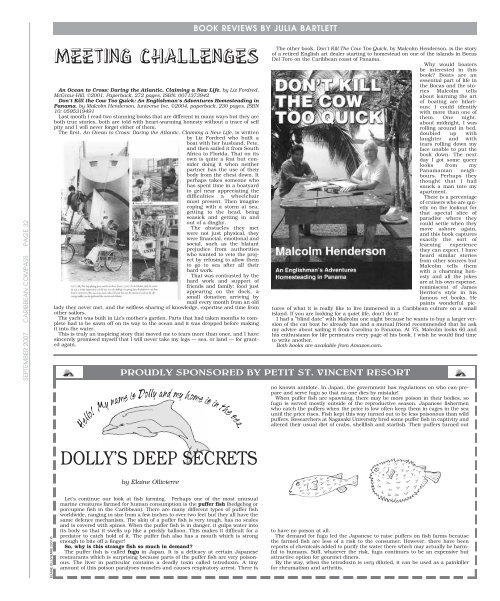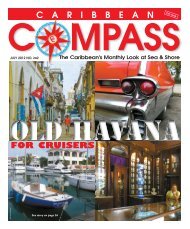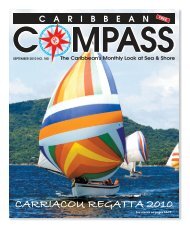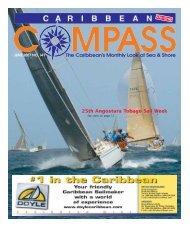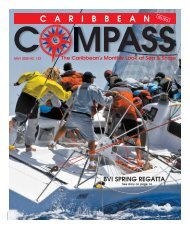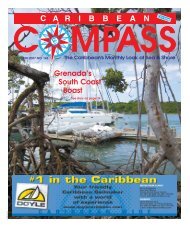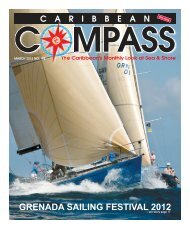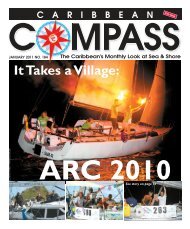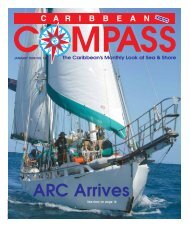Carriacou Regatta Festival 2007 - Caribbean Compass
Carriacou Regatta Festival 2007 - Caribbean Compass
Carriacou Regatta Festival 2007 - Caribbean Compass
Create successful ePaper yourself
Turn your PDF publications into a flip-book with our unique Google optimized e-Paper software.
SEPTEMBER <strong>2007</strong> CARIBBEAN COMPASS PAGE 32<br />
ELAINE OLLIVIERRE <strong>2007</strong> ©<br />
MEETING CHALLENGES<br />
An Ocean to Cross: Daring the Atlantic, Claiming a New Life, by Liz Fordred.<br />
McGraw-Hill, ©2001. Paperback, 272 pages, ISBN: 0071373942<br />
Don’t Kill the Cow Too Quick: An Englishman’s Adventures Homesteading in<br />
Panama‚ by Malcolm Henderson. Iuniverse Inc, ©2004, paperback, 230 pages, ISBN<br />
10: 0595319491<br />
Last month I read two stunning books that are different in many ways but they are<br />
both true stories, both are told with heart-warming honesty without a trace of self<br />
pity and I will never forget either of them.<br />
The first, An Ocean to Cross: Daring the Atlantic, Claiming a New Life, is written<br />
by Liz Fordred who built a<br />
boat with her husband, Pete,<br />
and then sailed it from South<br />
Africa to Florida. That on its<br />
own is quite a feat but consider<br />
doing it when neither<br />
partner has the use of their<br />
body from the chest down. It<br />
perhaps takes someone who<br />
has spent time in a boatyard<br />
to get near appreciating the<br />
difficulties a wheelchair<br />
must present. Then imagine<br />
coping with a storm at sea,<br />
getting to the head, being<br />
seasick and getting in and<br />
out of a dinghy.<br />
The obstacles they met<br />
were not just physical, they<br />
were financial, emotional and<br />
social, such as the blatant<br />
prejudice from authorities<br />
who wanted to veto the project<br />
by refusing to allow them<br />
to go to sea after all their<br />
hard work.<br />
That was contrasted by the<br />
hard work and support of<br />
friends and family: food just<br />
appearing on the dock, a<br />
small donation arriving by<br />
mail every month from an old<br />
lady they never met, and the selfless sharing of knowledge, expertise and time from<br />
other sailors.<br />
The yacht was built in Liz’s mother’s garden. Parts that had taken months to complete<br />
had to be sawn off on its way to the ocean and it was dropped before making<br />
it into the water.<br />
This is truly an inspiring story that moved me to tears more than once, and I have<br />
sincerely promised myself that I will never take my legs — sea, or land — for granted<br />
again.<br />
PROUDLY SPONSORED BY PETIT ST. VINCENT RESORT<br />
Hello! My name is Do ly and my home is in the sea.<br />
DOLLY’S DEEP SECRETS<br />
by Elaine Ollivierre<br />
Let’s continue our look at fish farming. Perhaps one of the most unusual<br />
marine creatures farmed for human consumption is the puffer fish (hedgehog or<br />
porcupine fish in the <strong>Caribbean</strong>). There are many different types of puffer fish<br />
worldwide, ranging in size from a few inches to over two feet but they all have the<br />
same defence mechanism. The skin of a puffer fish is very tough, has no scales<br />
and is covered with spines. When the puffer fish is in danger, it gulps water into<br />
its body so that it swells up like a prickly balloon. This makes it difficult for a<br />
predator to catch hold of it. The puffer fish also has a mouth which is strong<br />
enough to bite off a finger!<br />
So, why is this strange fish so much in demand?<br />
The puffer fish is called fugu in Japan. It is a delicacy at certain Japanese<br />
restaurants which is surprising because parts of the puffer fish are very poisonous.<br />
The liver in particular contains a deadly toxin called tetrodoxin. A tiny<br />
amount of this poison paralyses muscles and causes respiratory arrest. There is<br />
BOOK REVIEWS BY JULIA BARTLETT<br />
The other book, Don’t Kill The Cow Too Quick, by Malcolm Henderson, is the story<br />
of a retired English art dealer starting to homestead on one of the islands in Bocas<br />
Del Toro on the <strong>Caribbean</strong> coast of Panama.<br />
Why would boaters<br />
be interested in this<br />
book? Boats are an<br />
essential part of life in<br />
the Bocas and the stories<br />
Malcolm tells<br />
about learning the art<br />
of boating are hilarious;<br />
I could identify<br />
with more than one of<br />
them. One night,<br />
about midnight, I was<br />
rolling around in bed,<br />
doubled up with<br />
laughter and with<br />
tears rolling down my<br />
face unable to put the<br />
book down. The next<br />
day I got some queer<br />
looks from my<br />
Panamanian neighbours.<br />
Perhaps they<br />
thought that I had<br />
snuck a man into my<br />
apartment.<br />
There is a percentage<br />
of cruisers who are quietly<br />
on the lookout for<br />
that special slice of<br />
paradise where they<br />
could settle when they<br />
move ashore again,<br />
and this book captures<br />
exactly the sort of<br />
learning experience<br />
they can expect. I have<br />
heard similar stories<br />
from other sources but<br />
Malcolm tells them<br />
with a charming honesty<br />
and all the jokes<br />
are at his own expense,<br />
reminiscent of James<br />
Herriot’s style in his<br />
famous vet books. He<br />
paints wonderful pictures<br />
of what it is really like to live immersed in a <strong>Caribbean</strong> culture on a small<br />
island. If you are looking for a quiet life, don’t do it!<br />
I had a “blind date” with Malcolm one night because he wants to buy a larger version<br />
of the cat boat he already has and a mutual friend recommended that he ask<br />
my advice about sailing it from Carolina to Panama. At 75, Malcolm looks 60 and<br />
his enthusiasm for life permeates every page of his book. I wish he would find time<br />
to write another.<br />
Both books are available from Amazon.com.<br />
no known antidote. In Japan, the government has regulations on who can prepare<br />
and serve fugu so that no one dies by mistake!<br />
When puffer fish are spawning, there may be more poison in their bodies, so<br />
fugu is served mostly outside of the reproductive season. Japanese fishermen<br />
who catch the puffers when the price is low often keep them in cages in the sea<br />
until the price rises. Fish kept this way turned out to be less poisonous than wild<br />
puffers. Researchers at Nagasaki University bred some puffer fish in captivity and<br />
altered their usual diet of crabs, shellfish and starfish. Their puffers turned out<br />
to have no poison at all.<br />
The demand for fugu led the Japanese to raise puffers on fish farms because<br />
the farmed fish are less of a risk to the consumer. However, there have been<br />
reports of chemicals added to purify the water there which may actually be harmful<br />
to humans. Still, whatever the risk, fugu continues to be an expensive but<br />
attractive option for gourmet diners.<br />
By the way, when the tetrodoxin is very diluted, it can be used as a painkiller<br />
for rheumatism and arthritis.


